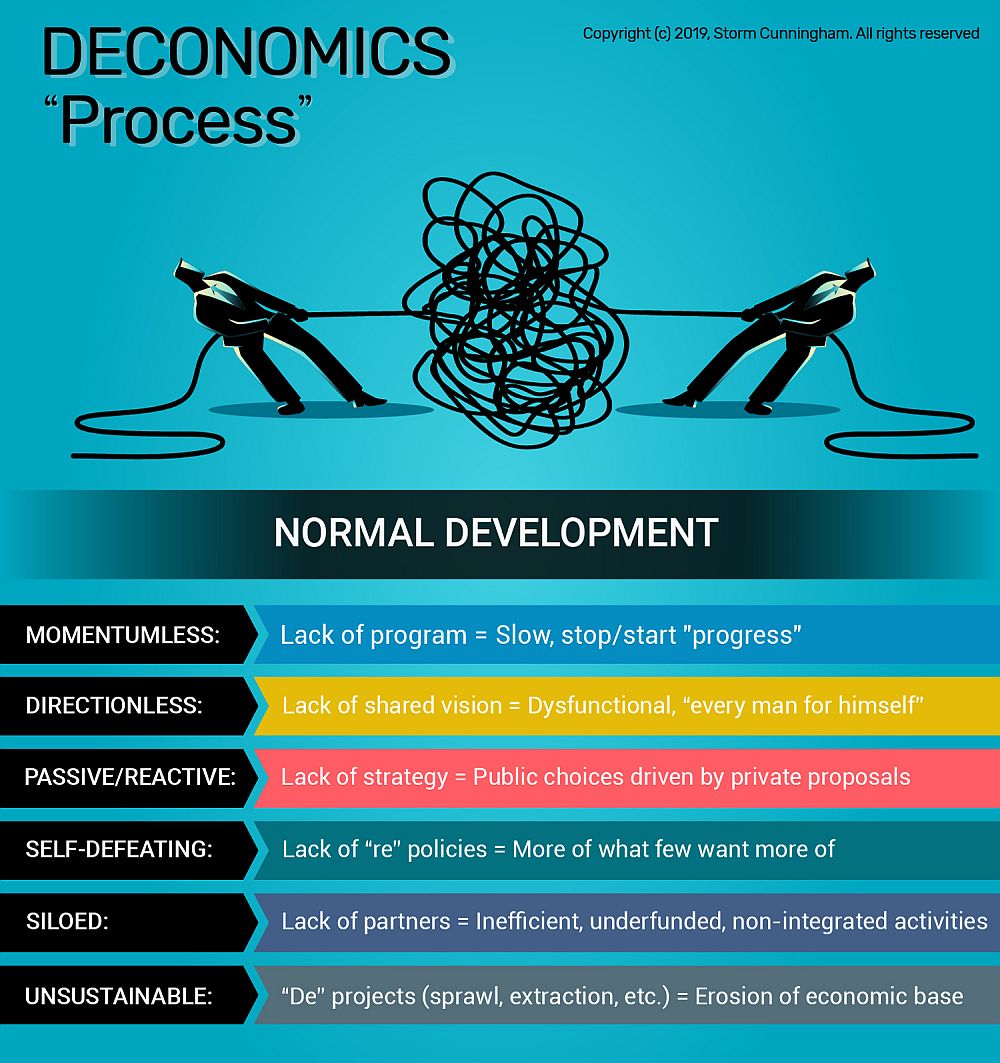THE RESTORATION ECONOMY: It takes a process to create an actionable vision for community revitalization + creekshed restoration, says Storm Cunningham
Note to Reader:
Author of three books and publisher of Revitalization: The Journal of Urban, Rural & Environmental Resilience, Storm Cunningham helps places worldwide revitalize with the assets they have today, to attract the resources they will need tomorrow.
Earlier in April, Storm Cunningham visited British Columbia to deliver two public lectures. First, at the Parksville 2019 Symposium his theme was Nature is Regenerative: We Should Be Too. Then, as part of the Place-Making Vancouver Island Speakers Series, he spoke  about “Revitalizing Communities by Restoring the Environment”.
about “Revitalizing Communities by Restoring the Environment”.
Afterwards, Storm Cunningham reflected on the ability of each audience to make the connection between their work and community revitalization, and how making that connection could benefit their work. Storm wondered whether they fully grasped why they should care about how communities revitalize.
This reflective process prompted Storm to contribute the following article in order to close the loop. The article will be incorporated in his next book. It provides a lens through which to understand why “Deconomics” describes the old way of doing business and “Reconomics” captures the new way.

STORM CUNNINGHAM’S SYNOPSIS OF THE “OLD BUSINESS AS USUAL” – How to do a lot of revitalizing projects, and NOT get revitalization!
“The first step is to create an ongoing revitalization (or resilience) program, which constantly initiates, perpetuates, evaluates and adjusts local renewal efforts,”says Storm Cunningham, author of The Restoration Economy
 Everywhere one turns these days, “re” words appear: urban regeneration; regenerative agriculture; economic revitalization, and so on. Storm Cunningham is a major catalyst in the global “re” trend. His contribution started with The Restoration Economy (2002).
Everywhere one turns these days, “re” words appear: urban regeneration; regenerative agriculture; economic revitalization, and so on. Storm Cunningham is a major catalyst in the global “re” trend. His contribution started with The Restoration Economy (2002).
Storm Cunningham points out that: “When collaboration goes beyond the watershed restoration ‘silo’, it can yield partnerships with local and regional revitalization efforts. This, in turn, can yiel new funding and political support for restoration.”
It takes a process to create an actionable vision for community revitalization + creekshed restoration
Hope is Not a Strategy:
“The short answer is that such understanding is the key to attracting more funding and more support (citizen and political) for their projects. If they better-understand how their work contributes to economic renewal and quality of life, they will be far more persuasive when it comes time to justify their budget. And if they better-understand the process of revitalization, they will know where best to insert themselves into local decision-making.
“The major flaw in that last statement is that most places don’t actually have a process for local renewal. They just tend to do a lot of projects, and hope that revitalization (or resilience) just magically appears as a reward for their hard work. But hope is not a strategy.”
Old Business As Usual
“Most people who are traditionally seen as being responsible for creating community revitalization—mayors, economic developers, private developers, planners, etc. – don’t actually know how to think about revitalization. Most of them tend to think of it as a goal, rather than as a process,” continues Storm Cunningham.
Silo Thinking:
- If they’re a mayor, they lead the way to revitalization via vision and deal-making.
- If they’re developers, they try to build their way to revitalization.
- If they’re architects or engineers, they try to design their way to revitalization.
- If they’re planners, they keep trying to plan their way to revitalization.
- If they‘re economics developers, they try to sell their way to revitalization.
- If they’re social activists, they try to organize or sue their way to revitalization.
- If they’re ecologists or watershed managers, they try to restore their way to revitalization.
“All are doing their best with what they have, but is it enough? Only rarely, when things somehow come together in the right place at the right time. We’re talking about the future of the place. Is hoping for the best the best we can do?”

The components are familiar, so all places have some. But none have all. A process with missing components is not a process. You can add to it, but do not subtract.
New Business As Usual
“This lack of process is a wonderful opportunity for those involved in reviving watersheds (or any other regenerative discipline, such as brownfields remediation, heritage restoration, infrastructure renewal, etc.) to advance those initiatives. Being the one at the table who actually understands how to organize local activities to increase their ROI (revitalization on investment) positions you to take on a real leadership role in the community or region,” notes Storm Cunningham.
Create An Actionable Vision to Build Momentum:
“Those who attended the Parksville event already have that knowledge. If you missed it, here’s a quick recap. The first step is to create an ongoing revitalization (or resilience) program, which constantly initiates, perpetuates, evaluates and adjusts local renewal efforts. Without an ongoing program, you have little chance of building momentum, which is essential to increasing confidence in the future of the place, which—in turn—attracts more residents, employers and funding.
“The first job of that program (which is usually housed by a foundation or non-profit organization) is to facilitate a shared visionfor the future. The second step is to create a strategy to implement that vision. Next, it’s best to do some policy work, adding policies to support that strategy, and removing policies that undermine it.”
Implement Projects Through Partnerships:
Role of the Stewardship Sector in the Process:
“Armed with a deep understanding of the above, Streamkeepers and other watershed heroes are no longer operating in a silo, dependent on others to champion and support their work. They are far more capable of being their own champions when face-to-face with funders, politicians and stakeholders.
“And, they will be better able to identify where in the revitalization/resilience process they or their organization should be engaged, in order to be most effective: the program, the visioning, the strategizing, the policymaking, the partnering or the projects,” concludes Storm Cunningham.

To learn more, visit https://revitalization.org/how-to-revitalize/#.XLuXRuhKjIV

